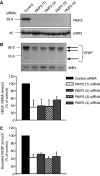Vascular endothelial growth factor-A and Poly(A) binding protein-interacting protein 2 expression in human head and neck carcinomas: correlation and prognostic significance
- PMID: 16641910
- PMCID: PMC2361268
- DOI: 10.1038/sj.bjc.6603108
Vascular endothelial growth factor-A and Poly(A) binding protein-interacting protein 2 expression in human head and neck carcinomas: correlation and prognostic significance
Abstract
Vascular endothelial growth factor-A (VEGF-A) has been demonstrated to play an important role in tumour angiogenesis and to influence prognosis in many cancers. However its prognostic value in head and neck squamous cell carcinomas (HNSCCs) remains controversial. Therefore, we investigated the clinical relevance of VEGF-A expression in HNSCCs and analysed whether its expression was associated with PAIP2 protein levels, a VEGF-A mRNA-binding partner that strongly regulates VEGF-A expression in tissue culture. We determined the correlation of VEGF-A and PAIP2 protein levels, quantitatively evaluated in tumour tissue homogenates from 54 patients with HNSCC, to clinicopathological parameters. We showed that VEGF-A expression in HNSCC is correlated to the stage of tumour differentiation (P=0.050) and is an independent prognostic factor for progression-free survival (P=0.001) and overall survival (P=0.0004). In a pharynx carcinoma cell line, we demonstrated by RNA interference that VEGF-A expression is closely controlled by PAIP2. Moreover, in human HNSCCs, VEGF-A expression is significantly correlated to PAIP2 protein levels (P=0.0018). Nevertheless, PAIP2 expression is associated with neither clinicopathological factors nor patient's survival. Our data suggest that, in contrast to PAIP2 protein levels, which are unrelated to tumour prognosis, VEGF-A expression could serve as a prognostic marker in head and neck cancer and may be helpful for targeted therapies.
Figures


References
-
- Bernier J, Domenge C, Ozsahin M, Matuszewska K, Lefebvre JL, Greiner RH, Giralt J, Maingon P, Rolland F, Bolla M, Cognetti F, Bourhis J, Kirkpatrick A, van Glabbeke M (2004) Postoperative irradiation with or without concomitant chemotherapy for locally advanced head and neck cancer. N Engl J Med 350: 1945–1952 - PubMed
-
- Calais G, Alfonsi M, Bardet E, Sire C, Germain T, Bergerot P, Rhein B, Tortochaux J, Oudinot P, Bertrand P (1999) Randomized trial of radiation therapy vs concomitant chemotherapy and radiation therapy for advanced-stage oropharynx carcinoma. J Natl Cancer Inst 91: 2081–2086 - PubMed
-
- Caponigro F, Formato R, Caraglia M, Normanno N, Iaffaioli RV (2005) Monoclonal antibodies targeting epidermal growth factor receptor and vascular endothelial growth factor with a focus on head and neck tumors. Curr Opin Oncol 17: 212–217 - PubMed
-
- Cohen EE (2004) Novel therapeutic targets in squamous cell carcinoma of the head and neck. Semin Oncol 31: 755–768 - PubMed
-
- Denkert C, Weichert W, Pest S, Koch I, Licht D, Kobel M, Reles A, Sehouli J, Dietel M, Hauptmann S (2004a) Overexpression of the embryonic-lethal abnormal vision-like protein HuR in ovarian carcinoma is a prognostic factor and is associated with increased cyclooxygenase 2 expression. Cancer Res 64: 189–195 - PubMed
Publication types
MeSH terms
Substances
LinkOut - more resources
Full Text Sources
Medical

